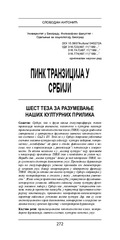Pink tranzicija u Srbiji - šest teza za razumevanje naših kulturnih prilika
Pink transition in Serbia: Six theses concerning our cultural situation
| dc.creator | Antonić, Slobodan | |
| dc.date.accessioned | 2021-10-12T11:53:29Z | |
| dc.date.available | 2021-10-12T11:53:29Z | |
| dc.date.issued | 2013 | |
| dc.identifier.issn | 0023-5164 | |
| dc.identifier.uri | http://reff.f.bg.ac.rs/handle/123456789/1754 | |
| dc.description.abstract | Srbija, kao i druge zemlje (polu) periferije, tokom tranzicije postaje ekonomska, politička i kulturna kolonija transnacionalne kapitalističke klase (TNKK) čije je središte (metropola) u centralnim društvima svetskog kapitalističkog sistema - SAD i EU. Tako se i u Srbiji dovršava uobličenje sistema masovne kulture koji odlikuju: kultura zaborava, potrošačkog 'oslobođenja' od greha i stida, fetišizma seksa i nasilja, kao i normalizacije ('relaksacije') patologije i amoralnosti. Te odlike nalazimo i u 'visokoj kulturi' koju proizvode i konzumiraju pripadnici TNKK (kao i kandidati za ulazak nju). Najveći deo 'visoke kulture' danas je pod kontrolom TNKK, koja suštinski diktira dominantni ukus. Pripadnici buržoazije koji na (polu) periferiji uspešno proizvode ili demonstriraju ispravan ukus, bivaju inkorporirani u ideokratsku frakciju TNKK. Otuda je gotovo sva visoka kultura u Srbiji sadržajno u znaku kompradorstva, a stilski u znaku 'konceptualne umetnosti'. I kao što je praktično nemoguće, u trenutnim društveno- istorijskim uslovima, odbaciti sadašnju glavnu kulturnu funkciju masovnih medija u Srbiji kao 'kolektora' potrošačke hipnoze, tako je praktično nemoguće, u trenutnoj društveno- istorijskoj konstelaciji, promeniti kompradorsko- kolonizatorski karakter ovdašnjih ustanova visoke kulture. Jer, one su samo institucionalni izraz dominantne, materijalno i socijalno hegemone klase u srpskom društvu - kompradorske buržoazije. | sr |
| dc.description.abstract | During transition, Serbia and other (semi) peripheral countries have become economical, political and cultural colonies of transnational capitalist class (TNCC) whose center (metropolis) is found in the main societies of the world capitalist system - the US and the EU. This has influenced the formation of the Serbian system of mass culture that is characterized by the culture of forgetting, the ideology of consumerist 'liberation' of sin and shame, fetishism of sex and violence, as well as normalization ('relaxation') of pathology and amorality. These features dominate also in the 'high culture' produced and consumed by TNCC members (and candidates for it). Most of the 'high culture' is now under TNCC control, which essentially dictates the dominant tastes. Members of the bourgeoisie, who successfully produce or demonstrate the right taste on the (semi) periphery, are incorporated into the idiocratic fraction of TNCC. Hence almost all high culture in Serbia is marked with comprador content and style, and also marked by 'conceptual art'. And since it is impossible, in the current socio-historical conditions, to reject the main cultural function of the mass media in Serbia as a 'collector' of consumer hypnosis, it is also impossible, in the current socio-historical constellation, to change the colonial comprador character of the institutions of high culture in Serbia. They are only an institutional expression of the dominant, financially and socially hegemonic classes in Serbian society - the comprador bourgeoisie. | en |
| dc.publisher | Zavod za proučavanje kulturnog razvitka, Beograd | |
| dc.relation | info:eu-repo/grantAgreement/MESTD/Basic Research (BR or ON)/179035/RS// | |
| dc.rights | openAccess | |
| dc.source | Kultura | |
| dc.subject | ukus | sr |
| dc.subject | transnacionalna kapitalistička klasa | sr |
| dc.subject | svetski sistem | sr |
| dc.subject | kulturni kapital | sr |
| dc.subject | kompradorska buržoazija | sr |
| dc.subject | transnational capitalist class | en |
| dc.subject | the world system | en |
| dc.subject | taste | en |
| dc.subject | cultural capital | en |
| dc.subject | comprador bourgeoisie | en |
| dc.title | Pink tranzicija u Srbiji - šest teza za razumevanje naših kulturnih prilika | sr |
| dc.title | Pink transition in Serbia: Six theses concerning our cultural situation | en |
| dc.type | article | |
| dc.rights.license | ARR | |
| dc.citation.epage | 292 | |
| dc.citation.issue | 140 | |
| dc.citation.other | (140): 272-292 | |
| dc.citation.rank | M51 | |
| dc.citation.spage | 272 | |
| dc.identifier.doi | 10.5937/kultura1340272A | |
| dc.identifier.fulltext | http://reff.f.bg.ac.rs/bitstream/id/626/1751.pdf | |
| dc.type.version | publishedVersion |

